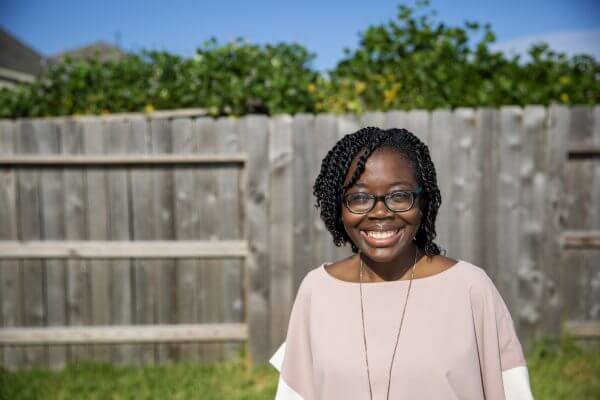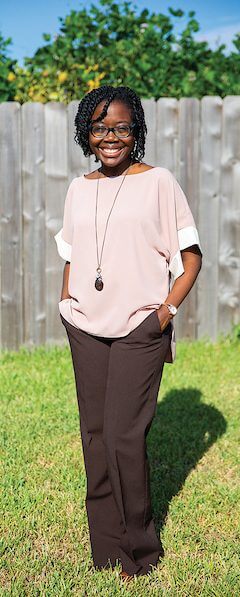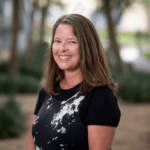A Houston physician with sickle cell opens up about treating patients with the same disease

Sickle cell disease has always been a part of me. As a young child, I knew sickle cell meant I was always at risk for having pain and that I would always be tired. That meant I couldn’t do everything everyone else was doing, otherwise I might get sick. For instance, if I played in the water during the day, I would probably have a pain crisis later that night. That was just the way things were.
I was inspired to become a doctor and help children with sickle cell disease because part of my childhood was spent in Nigeria, the capital of sickle cell. We’re the most populated country in Africa and the amount of people with the sickle cell mutation is much higher than in other places.
Sickle cell is an inherited blood disorder, a disease of hemoglobin—the molecules in red blood cells that deliver oxygen. When I meet with parents who have a young child with sickle cell, I explain that hemoglobin is like an army of backpacks that carry oxygen throughout the body. Having a disorder of these oxygen carriers is what causes health problems. Patients are anemic; they often feel weak and tired. If you challenge someone with sickle cell to a race, the person with sickle cell would get tired faster, because there’s less oxygen in their blood and less oxygen-carrying capacity.
Normally, red blood cells are circular, but sickled cells are shaped like crescent moons. Round blood cells can slide easily through tiny blood vessels, but sickle-shaped cells can clump and create blockages with inflammation, causing a traffic jam in your blood vessels. That’s what creates pain—pain that can be pretty excruciating. Some patients say it feels like having glass in their veins or being hit with a hammer.
And because it’s a blood disorder, it can affect any part of your body. This can be overwhelm-ing and upsetting for a family to hear, especially when they read on Google that the life span of a person with sickle cell is shorter than normal. I am quick to let parents know that sickle cell affects people in different ways and the average life span is increasing because of medical advancements. More importantly, I tell them that I see their child as having a fulfilling life. I explain to them that babies born in America are tested for sickle cell as part of a newborn screening program; therefore, we can monitor them closely as they grow and work with parents to prevent serious complications. For example, we start babies with sickle cell on low-dose penicillin twice daily in order to protect against severe infections. At the first sign of fever, we send them to the emergency room to be evaluated and preemptively treated. Because of these preventive measures, we are now seeing more than 90 percent of children making it to their 18th birthdays—and beyond.
Sickle cell disease affects about 100,000 Americans and, although it can be found in people of any ethnicity, it predominantly affects those with African ancestry. As such, in this country, it is a disease marked by a lot of historical neglect. The first time doctors identified sickle cells in the United States was 1910, but nothing really happened to help patients until the 1970s, when President Nixon passed the National Sickle Cell Anemia Control Act—in part because of pressure from family advocates, physicians and the Black Panther Movement. This legislation opened the door to sickle cell disease research programs, screenings and treatments centers. Even so, funding for sickle cell initiatives pales in comparison to funding for diseases that affect fewer people. In many ways, sickle cell disease parallels the historical struggles of blacks in America. But the winds of change are blowing due to ongoing advocacy by sickle cell champions.
Kindred spirit

But my parents, who met in the 1970s, didn’t talk about their status. They found out I had sickle cell when I was about 1. My mother noticed I was on the punier side and I seemed to get sick very easily. When I would cry, she couldn’t figure out what was wrong. After one of my huge crying fits she took me to the doctor, who tested me and found out I had sickle cell.
My parents’ first response, when I had pain, was not to go to the hospital. They would give me over-the-counter pain medication, massage the area until I felt better or fell asleep, and the crisis would eventually pass. I would have unpredictable horrible pain, in my belly and back or my arms and legs, but it was not an everyday occurrence. I learned how to manage most of my pain crises at home and I believe that helps a lot with how much you catastrophize the disease. Hence, my few trips to the hospital were usually for other sickle cell complications.
When I was 3, our family moved to Fort Worth, Texas, where my father went to seminary. I claim Fort Worth as my American hometown because that’s where I learned English and have my earliest memories, including my beloved elementary school education. My dad graduated while I was in 6th grade, and we went back to Nigeria. I was 11 years old.
That was when I got to know my cousin, Femi, the only other person in my family with sickle cell. She was three years older than me and I really looked up to her. We were similar in many ways. We were both calmer children, more on the rule-follower side. We even looked alike—eyes framed by glasses and long, beautiful hair. I’m a big fan of Anne of Green Gables and that book has this concept of the “kindred spirit.” Femi was that person to me.
One difference between us that amazed me was that Femi went to boarding school. Up until meeting her, I thought all children with sickle cell were day students like me. She always seemed very healthy. During the summer and school breaks, she and her siblings would come over and it was always great fun.
But one day when I returned home from school, my dad gathered us all and said, “Children, Femi has died. She passed away this past week.” My only death experience up to that point was my great-grandmother, who died at 108. Femi was 17. I was distraught by her death. It was the first time I had the experience of food tasting like sawdust.
Femi’s sister, Toyin, told me Femi had gotten sick and was taken to a local “hospital” that was very rudimentary. They didn’t even have oxygen. Femi was very weak and having trouble breathing. The doctors sent someone to drive several miles away to get oxygen. They told Femi’s family that was the best they could do. I still don’t know what caused her death. It may have been something we call acute chest syndrome— especially if they felt she needed oxygen—and that is a very serious condition that can lead to acute respiratory distress.
Femi’s death really shook me. By that time I had started reading my mother’s nursing textbooks, which stated that the average age of death for sickle cell patients was 18 years old. I was 15 and I just didn’t know what to do with that information. I became very depressed and my dad noticed this and endeavored to help me feel better. He said, “No one knows when they will die and life is not determined by a ticking time clock. It’s determined by how we spend our days. What do you plan to do with the time you have?”
I would be lying if I said I don’t occasionally worry about dying young, especially when I hear about the deaths of other people with sickle cell, each one a vibrant life gone too soon. As The Band Perry says in the song “If I Die Young”—
“the sharp knife of a short life.” At those times, I draw encouragement from my Christian faith, which is really the crux of my father’s words. Like the song, I want to be able to say, “Well, I’ve had just enough time.”
Life can still be beautiful
Having sickle cell myself wasn’t the trigger that made me become a doctor. But when Femi died, I thought: This shouldn’t happen.
I went to medical school in Galveston at The University of Texas Medical Branch, and my admission essay stated: I want to cure sickle cell. By my residency and fellowship applications, the essay had evolved. It said: I’m choosing pediatrics specifically because I want to reach sickle cell patients before they’ve defined how their lives are going to be. I want to give them hope. Fast forward to the present, where my experiences have taught me that sickle cell is a complex disease with several health care disparities and that there is still a lot of work that needs to be done. Now when I write essays, I say: I want to be an advocate for sickle cell disease. Caring for children with sickle cell has given me a purpose; my goal is to show them that life can still be beautiful.
One of the reasons I came to Baylor College of Medicine and Texas Children’s Hospital is because they have global health initiatives for pediatric hematology and oncology in sub-Saharan Africa. That meant the world to me, the fact that institutions in America are actually doing something for countries like my own, where the largest burden of sickle cell exists.
In addition to preventing severe infections, the current standard of care for the disease includes starting hydroxyurea, the first evidence-based sickle cell drug. Approved by the U.S. Food and Drug Administration for the treatment of sickle cell disease in 1998, hydroxyurea is what we call a “disease-modifying drug,” meaning it has been found to improve many of the complications in sickle cell. We are learning that the earlier we give it to patients, the better. Some of our children get close to normal numbers of hemoglobin! Even so, it does not remove all the risks and, like any chronic illness managed by medication, you must still be watchful for potential emergencies.
The only approved cure for sickle cell is a bone marrow transplant, also referred to as a stem cell transplant. However, it’s a complicated cure and not available to most people. For starters, you have to find a perfect match—even better if it’s someone in your family—and you need chemotherapy to help your body prepare for the trans-plant. A successful transplant removes the ability to make sickle cells, although the patient will still have sickle genes in their body.
The exciting news is that several drug companies are interested in making more disease-modifying drugs, so new sickle cell medications are currently in clinical trials and right around the corner. In fact, a second drug was approved in 2018. In addition, gene therapy clinical trials provide hope for a cure without requiring a donor. Baylor and Texas Children’s are among the institutions who participate in these important, long-awaited clinical trials.
We still have a long way to go, but I’m happy I’ve seen these changes in my lifetime. Sickle cell is a challenging disease, but we’re able to let families know that their children can make it. I’m happy that on this side of the planet, we’re able to change the story for kids. On the other side of the world, in my home country and elsewhere, we’re starting to change the story, as well.
Titilope Fasipe, M.D., Ph.D., is married to 1st Lt. Adedayo Fasipe (Chaplain Candidate, U.S. Army) and is aunt to several awesome children. Her first name, “Titilope,” means “forever grateful,” and that exactly sums up how she feels about her life, her faith and her family.




